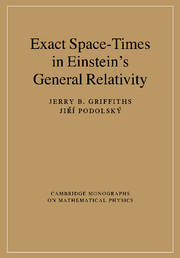Book contents
- Frontmatter
- Contents
- Preface
- 1 Introduction
- 2 Basic tools and concepts
- 3 Minkowski space-time
- 4 de Sitter space-time
- 5 Anti-de Sitter space-time
- 6 Friedmann–Lemaître–Robertson–Walker space-times
- 7 Electrovacuum and related background space-times
- 8 Schwarzschild space–time
- 9 Space-times related to Schwarzschild
- 10 Static axially symmetric space-times
- 11 Rotating black holes
- 12 Taub–NUT space-time
- 13 Stationary, axially symmetric space-times
- 14 Accelerating black holes
- 15 Further solutions for uniformly accelerating particles
- 16 Plebański–Demiański solutions
- 17 Plane and pp-waves
- 18 Kundt solutions
- 19 Robinson–Trautman solutions
- 20 Impulsive waves
- 21 Colliding plane waves
- 22 A final miscellany
- Appendix A 2-spaces of constant curvature
- Appendix B 3-spaces of constant curvature
- References
- Index
7 - Electrovacuum and related background space-times
Published online by Cambridge University Press: 04 February 2010
- Frontmatter
- Contents
- Preface
- 1 Introduction
- 2 Basic tools and concepts
- 3 Minkowski space-time
- 4 de Sitter space-time
- 5 Anti-de Sitter space-time
- 6 Friedmann–Lemaître–Robertson–Walker space-times
- 7 Electrovacuum and related background space-times
- 8 Schwarzschild space–time
- 9 Space-times related to Schwarzschild
- 10 Static axially symmetric space-times
- 11 Rotating black holes
- 12 Taub–NUT space-time
- 13 Stationary, axially symmetric space-times
- 14 Accelerating black holes
- 15 Further solutions for uniformly accelerating particles
- 16 Plebański–Demiański solutions
- 17 Plane and pp-waves
- 18 Kundt solutions
- 19 Robinson–Trautman solutions
- 20 Impulsive waves
- 21 Colliding plane waves
- 22 A final miscellany
- Appendix A 2-spaces of constant curvature
- Appendix B 3-spaces of constant curvature
- References
- Index
Summary
The Minkowski, de Sitter and anti-de Sitter space-times described in Chapters 3–5 are the only conformally flat solutions of Einstein's vacuum field equations with a possibly non-zero cosmological constant. However, there also exist non-vacuum conformally flat space-times. The most important of these are the perfect fluid FLRW cosmologies that were reviewed in the previous chapter. Conformally flat radiative space-times with pure radiation will be discussed in Chapters 17 and 18. Another important conformally flat space-time is the Bertotti–Robinson universe which contains a uniform non-null electromagnetic field.
Interestingly, the Minkowski, de Sitter and anti-de Sitter solutions are constant-curvature 4-spaces (with ten isometries), the FLRW cosmologies (having six isometries) are foliated by constant-curvature 3-spaces, while the Bertotti—Robinson space-time is a direct product of two 2-spaces of constant curvature (and so also has six isometries). In fact, it belongs to a larger family of geometries of this type, which also include the Nariai, anti-Nariai and Plebański–Hacyan direct-product space–times. In general, these are electrovacuum solutions, which apart from the Bertotti—Robinson solution are of algebraic type D. These will all be described in this chapter.
It is also natural here to include a short description of the Melvin universe, which is another interesting electrovacuum type D solution.
The Bertotti–Robinson solution
The conformally flat solution of the Einstein–Maxwell equations for a nonnull electromagnetic field was obtained independently by Bertotti (1959) and Robinson (1959), see also Levi-Civita (1917).
- Type
- Chapter
- Information
- Exact Space-Times in Einstein's General Relativity , pp. 95 - 105Publisher: Cambridge University PressPrint publication year: 2009

